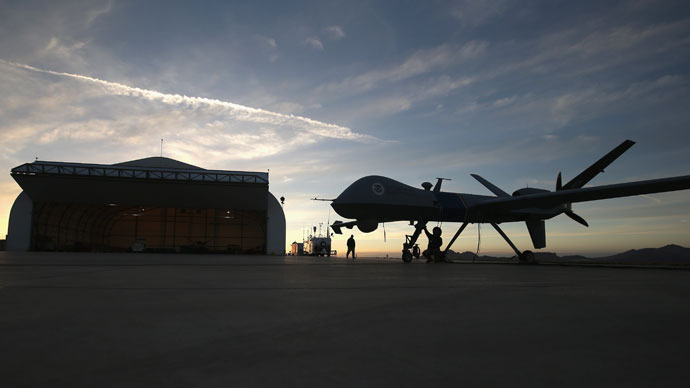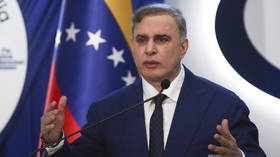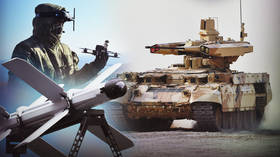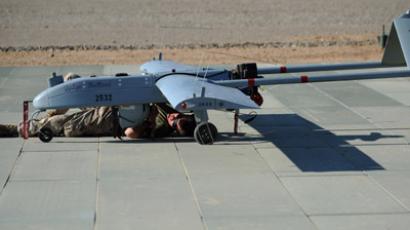Leaked report: Nearly half of US drone strikes in Pakistan not against al-Qaeda

A trove of leaked classified reports has confirmed what many had suspected – US drone kills in Pakistan are not the precision strikes against top-level al-Qaeda terrorists they are portrayed as by the Obama administration.
Instead, many of the attacks are aimed at suspected low-level tribal militants, who may pose no direct danger to the United States – and for many there appears to be little evidence to justify the assassinations.
Top secret documents obtained by McClatchy newspapers in the US show the locations, identities and numbers of those attacked and killed in Pakistan in 2006-8 and 2010-11, as well as explanations for why the targets were picked.
The statistics illustrate the breadth of the US ‘drone doctrine’ – which has never been defined by consecutive US administrations. Between 1,990 and 3,308 people are reported to have been killed in the drone strikes in Pakistan since 2004, the vast majority of them during the Obama terms.
In the 12-month period up to 2011, 43 out of 95 drone strikes in
the reports (which give an account of the vast majority of US
operations in the country) were not aimed at al-Qaeda at all. And
265 out of 482 people killed in those assassinations, were defined
internally as “extremists”.
Indeed, only six of the men killed – less than two percent – were senior al-Qaeda leaders.
Some of the groups include the Haqqani network and the Taliban Movement of Pakistan, both militant organizations, but ones the US did not designate as terrorists until 2012 and 2010 respectively. Neither one has ever conducted an attack on US soil.
It also confirms that attacks during the George W. Bush era, were conducted on targets picked by ISI, Pakistan’s security agency, which has no obligations to comply with US legal criteria.
Furthermore, in some cases it is difficult to confirm that the targets were militants at all.
In the strikes above, the internal reports showed that only one
civilian had been killed. But the modus operandi revealed behind
the strikes, shows that some of the attacks seem to have been based
on the certain people or visitors being present as certain
locations, or merely associating with those the US believes were
terrorists. This chimes with the accusation that the US is carrying
out a policy of “signature strikes” – attacks based on
behavior, or “signature” that would be expected of a
terrorist, rather than any specific illegal activity.
These “signatures” apparently include such suspicious behavior as taking part in a funeral procession or first responding to an initial drone strike. Last year, the United Nation’s special rapporteur on human rights and counter-terrorism, Ben Emmerson, said it’s believed that, “since President Obama took office, at least 50 civilians were killed in follow-up strikes when they had gone to help victims and more than 20 civilians have also been attacked in deliberate strikes on funerals and mourners.”
The US has previously refused to admit that it operates such a
policy.

Some of the assassinations, such as that of, Mohammad, the
younger brother of the leader of the Haqqani network, Badruddin,
appear to have been simply errors, with the victims branded as
terrorists only after the fact.
All this seems to go against the assurance of John Brennan, the
former White House counterterrorism chief, and new CIA head, who is
the mastermind behind the drone policy
“We only authorize a particular operation against a specific individual if we have a high degree of confidence that the individual being targeted is indeed the terrorist we are pursuing,” Brennan explained a year ago.
Obama’s administration has also said all targets are on a “list of active terrorists,” compiled with “extraordinary care and thoughtfulness”. Obama has also explicitly stated that drones should not carry out “speculative” killings.
But other than when ordering assassinations of US citizens, the President does not have to give full information to the Senate about the basis for any drone attack, much less give it a legal justification.
The latest revelations have unleashed a torrent of protest from experts who believe that the program is extra-judicial, violates Pakistan’s sovereignty, and is counter-productive in the long term.
“I have never seen nor am I aware of any rules of engagement
that have been made public that govern the conduct of drone
operations in Pakistan, or the identification of individuals and
groups other than al Qaida and the Afghan Taliban,” Christopher
Swift, a national security law expert from Georgetown University
told McClatchy.
“We are doing this on a case-by-case, ad hoc basis, rather
than a systematic or strategic basis.”
Micah Zenko, from the Council on Foreign Relations, a foreign policy think tank, went further, and accused the government of“misleading the public about the scope of who can legitimately be targeted.”
He added: “When there is such a disconnect between who the administration says it kills and who it actually kills, that hypocrisy itself is a very dangerous precedent that other countries will emulate.”
Last month Ben Emmerson, after a secret research trip to the country announced that drone strikes violate Pakistan's sovereignty.
Emmerson added that the Pakistani government conveyed to him that it does not consent to the attacks, something that is often challenged in Washington and fuels mass protests in Pakistan.

Drone strikes were first used after the 9/11 attacks from bases in Pakistan and Uzbekistan, in combat missions inside Afghanistan. More than a decade later, Washington has expanded the use of the remotely controlled aircraft into Yemen, Somalia and most of all Pakistan.
The US has carried out countless attacks on targets in northwest Pakistan since 2004 through the CIA’s Special Activities Division. Begun by President George W. Bush, the intensity of the missions has increased under the presidency of Barack Obama.
Islamabad publicly condemns these attacks but is known to have shared intelligence with the US and allowed drones to operate from its territory until April 2011, when NATO forces killed 24 Pakistani soldiers in the Salala incident. WikiLeaks cables also revealed that Pakistan's Army Chief Ashfaq Parvez Kayani sanctioned the flights and in 2008 even asked the CIA for more “Predator coverage.”
Ordinary Pakistanis have also repeatedly protested against these attacks as a violation of its sovereignty and because of immense civilian collateral damage, including the death dozens of women and children.














